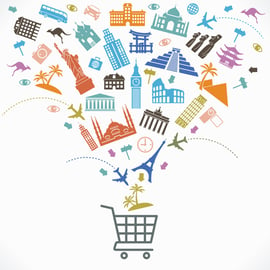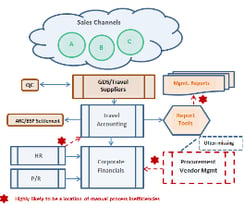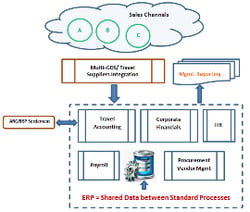To the public eye travel is a straightforward concept focused on destinations, activities, tickets and itineraries. For those who work in the travel industry it’s always been a complicated set of interrelationships between retailers, wholesalers and service providers – made, if anything, even more challenging by the global reach of the Internet. Two of the more visible ways the Internet has changed the travel are: 1) raised customer expectations for a unique and amazing travel experience; 2) price transparency – customers can book much of their travel directly online, or have travel plans in mind and quotes in hand before the first conversation with atravel agent. 
Another way the Internet has change travel is far less visible but much more profound: it has dramatically altered the way travelers see their role and the role played by travel agencies and travel management companies. Twenty years ago a travel business – particularly for international travel – had a much more of a guardian role than would ever be imagined today. For example, what millennial could explain a traveler’s check? Yet instant, global, replacement of travel’s checks was the original business benefit that led to the American Express company everyone recognizes today. Similarly, the ubiquitous global presence of Thomas Cook travel agency storefronts gave it a competitive advantage over regional and national chains.
Now travelers need less hand-holding and more knowledge with higher service levels. This means business models are changing in every link of the travel service chain and the travel technologies that sufficed twenty – or even ten – years ago simply won’t do the job anymore.
The Travel Technology Challenge
And what job is that? Actually its several jobs: facilitating customer travel services; executing business processes, and supporting management decision-making.
The vast majority of private travel businesses start out with what technologists would call a “distributed architecture” – a term which means a business begins with a number of separate software applications and adds or upgrades to them as needed. For example:
GDS: This is a software platform that makes it possible for travel agencies to immediately access availability and pricing for airline, hotel, car rentals and other travel services. This allows agents to compare prices, schedules, travel information and reservation options and book client decisions.
ARC/BSP: These software systems are designed to enable the selling, reporting and remitting procedures of airline and rail tickets by accredited sales agents. ARC covers United States carrier bookings and BSP covers International bookings.
Travel Accounting: travel businesses require specialized accounting software that can: track of supplier invoices; calculate and pay commissions; match invoices to customer travel bookings, adjust for cancellations or discounts, then pay those invoices and bill customers.
Payroll: many travel businesses also have payroll software systems, though some choose to outsource this relatively standardized process to third party service providers.
Financial Accountings: travel companies generally have obligations to submit financial statements to banks and credit agencies, which require a general accounting system in addition to specialized travel accounting software.
Having separate software systems does not necessarily cause issues when a company is small and information is not voluminous. However, as the company grows, having information in separated systems means it is impossible to share it or produce integrated reporting without programming interfaces between the systems or manually copying data from one system and pasting it into another.
If silos of data just meant inefficient, mind-numbing, repetitive work it would be regrettable but not necessarily a pressing business challenge. But it also affects customers. For example, managing product and service pricing displayed on the company website - or updating destination and service descriptions and photographs. Unless a travel company can maintain focus on providing service to the customer, and not manually compensating for limited software capabilities, it will not be highly competitive.
The Travel ERP Solution
An enterprise resource planning (ERP) system addresses the issues of a distributed architecture by providing a travel business with an integrated suite of applications for front office, mid-office and back office business processes. The ERP suite has the ability to eliminate silos of isolated data and business activities with a common data model and standardized processes across key functions for: accounting, payroll; HR; supply chain, CRM & procurement. As shown in this graphic, the suite of travel-specific applications is designed to work smoothly and interchangeably with each other.
A common data model and standard processes are considered the heart of ERP travel technology because it is lack of one or both that drives the majority of required manual activities in component-based, distributive systems. With common data structures, information can be designed for use one time, and then simply updated with minor tweaks going forward; reporting is quick and flexible and BI becomes a reality and a competitive weapon. With standard processes, structured data can flow in a smooth automated workflow from one application to another: for example, payroll into account costing. Employees can focus on delivering high value and innovations and less on internal activities the customer knows little about and cares even less.
What about cost? For many people in the travel industry, the term “ERP system” brings to mind the image of a monolithic, expensive, unwieldy, software solution appropriate for global companies like Lufthansa or ExxonMobil. In fact, the last five years has seen rapid ERP innovation resulting in smaller, nimbler systems targeted at specific industries: the travel industry being a case in point. These systems are aimed at small to mid-sized companies, both in terms of range of functionality and also investment cost.
For example, dcs plus offers TINA, one of the most advanced web-based travel ERP systems in the world. Yet it is also designed to match the needs and capabilities of each customer as they prosper and change – which means a single-site travel agency can afford the technology and use it to expand into a full service travel management company. Imagine, with TINA, now even start-ups on the first rung of the travel ladder can: automate processes; increase visibility and control; increase efficiency; control business processes; create reports – and change business strategy on the go.
What are you waiting for?
















